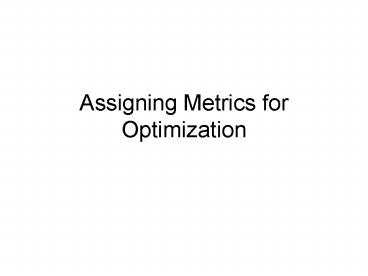Assigning Metrics for Optimization - PowerPoint PPT Presentation
1 / 12
Title:
Assigning Metrics for Optimization
Description:
Example: A car can be ranked by mileage, top speed, number of gears, and seating ... must be specified for each EM: Sometimes, lower ratings are preferred ... – PowerPoint PPT presentation
Number of Views:12
Avg rating:3.0/5.0
Title: Assigning Metrics for Optimization
1
Assigning Metrics for Optimization
2
Evaluation Measures
- Each evaluation measure (EM) is a category by
which an option is ranked/graded - Example A car can be ranked by mileage, top
speed, number of gears, and seating capacity. - A metric (or value function) must be established
for each EM
3
Value Functions
- A single value metric must be specified for each
EM - Sometimes, lower ratings are preferred
- Example lower cost
- Sometimes, higher ratings are preferred
- Example higher mileage
- Choose the one that is applicable to the case.
- The scale of each metric must then be normalized
to a range of 1.
4
Choosing a Value Function for an Evaluation
Measure
- There are two types of value functions
- Piecewise linear
- Used for arbitrary scales of performance,
attractiveness, etc. - Few data points are available
- Good for expressing discontinuity
- Exponential
- Used for stress, deflection, and other physical
or concrete factors. - Many data points can be obtained
- Suitable for incorporating a risk factor
5
Example Piecewise Linear Value Function
- The x-axis shows the grading scale for
productivity (chosen arbitrarily) - The y-axis shows the relative value of each grade
- In this case, an improvement from a grade of -1
to 0 is as much as an improvement from 0 to 2.
6
Risk Tolerance
- How daring is the decision maker?
- Risk tolerant report a better score than is
calculated by the metric (positive r) - Risk averse report a worse score than is
calculated (negative r) - Risk neutral report the actual score (r?)
- The risk level r can be
- Calculated using the method in the next slide
- Estimated by looking at the different graphs
shown in the following slides or created by a
simulation.
7
Technical Method for Solving ?
- ? gt 0.1 Range of Measurement
- Find mid-value score (i.e. value 0.5)
- Assign value of 0.5 to a specific score
- Solve numerically or use a table
- Calculate normalized mid-value (range of scores ?
1) - Find normalized ?
- De-normalize ? by multiplying by the range
8
Exponential Value Function
- Higher scores are better
- Risk tolerance r
- r gt 0 risk tolerant
- r lt 0 risk averse
9
Exponential Value Function (cont.)
- Lower scores are better
10
Final Evaluation
- Combine value function grades with their
respective weights to calculate the final
grade/value
11
Bicycle Example
- In our example, the EMs are
- Cost
- Measured in dollars
- Lower score is preferred
- Weight
- Measured in pounds
- Lower score is preferred
- Lifetime
- Measured in months
- Higher score is preferred
12
Bicycle Example (cont).
- We use the exponential value function.
- Use a risk-averse outlook for personal safety,
e.g. set ? -5. - The exponential value function has been built
into an MS Excel module and will be
explained/utilized in later lectures.































